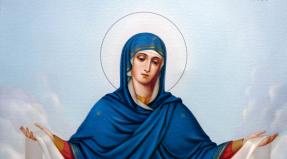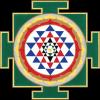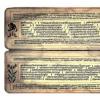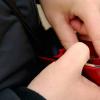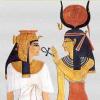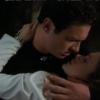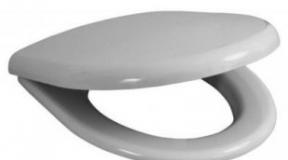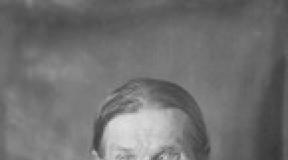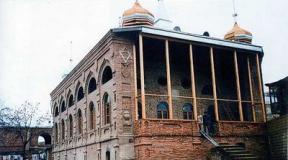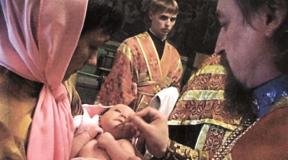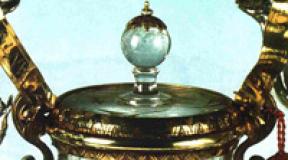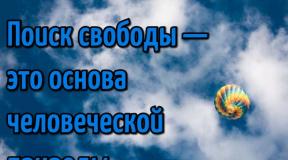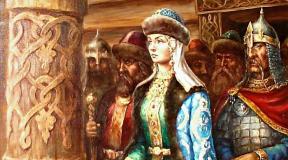Animals of the evangelists. Symbols of the saints
1. Why are saints symbolized on icons by animals (eg Luke, in my opinion, by a bull)?
2. Why are "Clothes of leather" only sins, and not the earthly body itself? After all, it is logical to assume that death exists if there is a body that can die.
The priest Afanasy Gumerov, a resident of the Sretensky Monastery, answers:
1. The holy apostles-evangelists from the II century learned the symbols: angel, lion, calf (bull), eagle. They go back to the prophetic visions of four animals. The heavens opened to the prophet Ezekiel by the river Chebar and he saw four animals out of the midst of the fire: “ The likeness of their faces is the face of a man, and the face of a lion on the right side of all four of them; and on the left side the face of a calf for all four, and the face of an eagle for all four”(1:10). A vision of mysterious animals was also seen by St. to the Apostle John the Theologian: “ and before the throne is a sea of \u200b\u200bglass like crystal; and in the middle of the throne and around the throne are four animals full of eyes in front and behind. And the first animal was like a lion, and the second animal was like a calf, and the third animal had a face like a man, and the fourth animal was like a flying eagle.”(Rev. 4: 6-7). In the patristic interpretation, these animals symbolize the four evangelists. Each of them, according to the transmission of the main events of the Holy New Testament history, at the same time complement each other, paying more attention to any side of the Person of the Savior. Matthew shows Him as a perfect, sinless Man (therefore, an angel was adopted as a symbol), Mark depicts Christ as the King (the royal animal is the lion), Luke as the incarnate God who sacrificed Himself for the sins of people (the sacrificial animal is a calf), John as who conquered death and ascended to God the Father (eagle).
The earliest depiction of these symbolic animals is a mosaic from the beginning of the 5th century in the church of St. Pudentians in Rome (in the apse).
2. In patristic exegesis, there are two understandings mentioned in the book of Genesis “ leather clothes " (« And the Lord God made skins for Adam and his wife, and clothed them ”, 3:21). Saint Gregory the Theologian understood by them the coarse and mortal flesh that man acquired as a result of the Fall. Others talk about real clothes that began to cover the nakedness of their ancestors.
Symbols of the Evangelists
images of four living beings, which the ancient iconographic tradition appropriated to the evangelists; as is commonly believed, these symbols are borrowed from the vision of John the Theologian. The symbols reveal various aspects of the redemptive feat and teachings of the Savior as presented by the evangelists. Under the Evangelist Matthew, the Angel is portrayed as a symbol of the messianic mission to the world of the Son of God, predicted by the prophets. Mark the Evangelist is symbolized by a lion, to commemorate the power and dignity of Christ (see Rev. 5, 5). The Evangelist Luke is depicted with a calf, emphasizing the sacrificial, redemptive ministry of the Savior. The eagle under the evangelist John depicts the height of the gospel teaching and the divine Mysteries communicated in it. On some ancient icons and frescoes, these symbols, having the same meaning, are combined in a different order. The images of the four evangelists and the creatures symbolizing them in the traditional composition of the murals of an Orthodox church are usually placed on the four sides of the cross-domed vault, on the so-called "sails" supporting the dome, inside which the Lord Almighty is usually depicted.
Orthodoxy. Dictionary-reference. 2014 .
See what the "Symbols of the Evangelists" are in other dictionaries:
Evangelical symbols - ... Wikipedia
Symbols of the Evangelists - ... Wikipedia
Symbols of the saints - Virgo inter virgines ("Virgin among virgins"), an unknown artist of the late 15th century. Virgin Mary among other holy virgins (eg Holy Aha ... Wikipedia
Tetramorph - The vision of the prophet Ezekiel (Raphael, 1518) Tetramorph (Greek ... Wikipedia
Kabbalistic animals
Kafziel - The vision of the prophet Ezekiel (Raphael, 1518) Tetramorph (Greek τετραμορφος four-shaped) in Judeo Christian mythology and theology is a winged creature from the vision of the prophet Ezekiel, one with four faces: a man, a lion, a calf and an eagle. In ... ... Wikipedia
Winged calf - The vision of the prophet Ezekiel (Raphael, 1518) Tetramorph (Greek τετραμορφος four-shaped) in Judeo Christian mythology and theology is a winged creature from the vision of the prophet Ezekiel, one with four faces: a man, a lion, a calf and an eagle. In ... ... Wikipedia
Book of kells - p. folio 292r: the beginning of the gospel ... Wikipedia
Book of Kels
The Book of Columba - Page (folio 292r) containing an ornate text, the beginning of the Gospel of John The Book of Kells (also known as The Book of Columba, Irish Leabhar Cheanannais) a richly illustrated handwritten book by the Irish (Celtic) ... ... Wikipedia
Everything we know about God is stated in the Gospels. Their authors are 4 apostles-evangelists. Matthew, Mark, Luke, John.
In the times described by the Bible, all missionaries who preached Christianity to Jews and pagans were considered evangelists. But the 4 evangelists, who will be discussed, did a special job - they wrote four great books, from which the human race learned about Christ's love, forgiveness, repentance and salvation.
John is a fisherman, the only apostle who died a natural death

- Symbol - eagle or lion;
- Life span - 72 years old;
- Books -Gospel of John, 1, 2, 3 of John, Revelation;
- Death -natural, by age.
Christians know him by his second name - the Theologian. In his gospel, he called Jesus the Word of God ("In the beginning was the Word and the Word was with God and the Word was God" John 1: 1).
Jesus Christ called him "Son of Thunder" - for his impetuosity and emotionality. John was a simple fisherman. After being called into the ranks of Jesus' disciples, the apostle never left Him.
The Evangelist saw the miracles of Jesus: the resurrection of the daughter of Jairus, the Transfiguration at Tabor. He was with Him at the Last Supper. On the day of his execution, Jesus commissioned John to take care of His mother.
John preached Christianity, cast out demons from temples, healed the sick, raised the dead. Unlike other apostles, John died naturally. When his hour came, the saint prayed, lay down in a previously prepared grave and asked the disciples to bury him.
Later, other students dug up the grave, but found nothing in it.
Matthew is a tax collector, a representative of one of the infamous social groups of the time

- Symbol -angel or person;
- Date of Birth -1st century AD;
- Date of death -74 C.E.
- Books -The Gospel of Matthew;
- Death -killed by sword in Ethiopia.
Little is known about the Evangelist Matthew. Scripture says that Levi Matthew was a tax collector (such people were called "tax collectors"). One day he heard the voice of Jesus who told him: "Follow me." Since then, Matthew left his job and home and followed Christ relentlessly. Before that, he distributed property to the poor. He witnessed many miracles of the Savior. I went through suffering with my Teacher. I saw how He died, rose again and ascended into heaven.
Matthew preached in Palestine, Persia, Media, Syria and Parthia. He continued his Christian activity in Ethiopia, where it was cut short by the martyrdom appointed by the ruler Fulvian.
The Gospel of Matthew is the first among all the books of the New Testament. In it, Matthew often refers to the Old Testament, showing that the prophecies written in it came true with the appearance of Jesus Christ.
Mark is an evangelist who did not see Christ, but wrote the gospel from eyewitnesses

- Symbol -lion or eagle;
- Date of Birth -1st century;
- Date of death -A.D. 68 .;
- Books -The Gospel of Mark;
- Death -was burned for his faith in Alexandria.
Mark was born in Jerusalem. From childhood he was surrounded by the successors of Christ. His mother sacredly believed in the teachings of Christ. Mark was close with his uncle the Apostle Barnabas, the teacher - the Apostle Peter, the Apostle Paul. The saint worked with them and preached in Seleucia, Rome, Egypt, Antioch, and Cyprus.
He became the founder of many churches and a Christian school. Traveling across Africa, Libya, Nectopolis, the apostle carried God's word to people. Mark died in Alexandria at the hands of pagans who disagreed with the teachings of Christ. The Gospel of Mark was written by him in Rome and was intended for converts to the Christian faith pagans.
Luke - physician by profession, assistant to the Apostle Paul

- Symbol -bull, calf;
- Life expectancy -84 years old;
- Books -The Gospel of Luke, the Acts of the Holy Apostles;
- Death -was hanged for his faith in Thebes.
Luke is another companion of the Apostle Paul. Born in Antioch, he was a doctor, by birth - Greek. He began to preach while Jesus was still alive. He was Paul's companion for many years. After Paul's martyrdom, Luke continued his sermons in Libya, Egypt, Thebais and Achaia.
Then he preached in Thebes, where he died a cruel death by hanging. In addition to the Gospel, Luke wrote the Acts of the Holy Apostles. He is also credited with writing many icons found in Russian, Roman, Western churches, as well as on Athos.
These are the four evangelists in the scriptures. Of no less interest are the symbols of the apostles and evangelists.
What symbols did these four evangelists have?
The symbols of the four evangelists appeared in the earliest depictions of saints. Initially, they were represented in the form of four rivers of paradise. Then the symbols of the four animals appeared that surround the throne of Jesus.
For the first time, these creatures are found in the Old Testament in the vision of Ezekiel, where they appear as the guards of the Throne of the Lord with the faces of a man, a calf, a bull and an eagle.
In the second century, Irenaeus of Lyons offers the following symbolism:
- John is the image of an eagle;
- Matthew is the face of an angel, or a man;
- Mark is the image of a lion;
- Luke is the image of a bull.
Blessed Jerome connects the image of a certain living being and the evangelist as follows:
- John is a lion's image;
- Matthew is a human face;
- Mark is the image of an eagle;
- Luke is the image of a calf.
There are three versions that interpret the symbols of the apostles evangelists.
One of them suggests that the symbol of the Apostle Matthew is the human life of Jesus on earth. Luke's symbol, the bull, embodies the sacrifice of Christ for the salvation of people. The Savior is resurrected as a symbol of John the lion. And soars into heaven, like an eagle - the symbol of the Evangelist Mark.
Jerome explains the symbols as follows:
- Matthew in his gospel reflects the human origin of Jesus, his kind;
- Markdescribes the word of the Baptist John resounds like a lion's roar in the wilderness;
- Lukedescribes the sacrifice of Zechariah, which can be compared with the pagan custom of sacrificing a bull;
- John:its sublime syllable is reminiscent of the high flight of an eagle.
For the Jerusalem patriarch Sophrony, a person means the appearance of Jesus in the flesh, a lion means the ability of Christ to lead, a calf means the Savior's service to people, an eagle means the embodiment of the holy spirit.

The four gospels describe and reveal the life path and teachings of Jesus Christ from different angles. The names of 4 evangelists: Matthew, John, Mark, Luke, entered the history of Christianity.
Originally posted by vladmow
at Tetramorph. History of the origin of man, lion, eagle and ox
Friends, I think that most of those present here are quite erudite and have some idea of \u200b\u200bfour animals: lion, eagle, bull and man. With sometimes my characteristic causticity, I decided to dig a little deeper into this issue and clarified for myself many new and interesting facts, for the history of these symbols is very ancient. What I will tell you with pleasure.
These are the symbols of the four evangelists, you say, and you will be right. However, you must understand that the editors could not allow such a terrible boyan, so let's start with an even more terrible boyan, but closer to us on the timeline. Three of these four animals are mentioned in the song of Boris Grebenshchikov The Golden City:
One like a yellow firemane lion
Another ox full of eyes.
With them is the golden eagle of heaven,
Whose eyes are so bright and unforgettable.
"Evangelists!" - you will happily say, "Not yet." - I will answer you. The next timeline from now to the past is the mention of this sivol on the coat of arms of the Great Masonic Lodge of England.
And now the evangelists. The generally accepted identification of each of the four animals with one of the evangelists belongs to Jerome. According to his preface to the commentary on the Gospel of St. Matthew the sequence of the evangelists is as follows: the first is St. Matthew, followed by St. Mark, St. Luke and, finally, St. John. Then Jerome compares this order, the order of the appearance of the “faces” of the four beasts in the vision of the prophet Ezekiel (see below).
Thus it turns out: St. Matthew is symbolized by a man (angel), St. Mark - lion, St. Luke the calf, St. John is an eagle. At first, the evangelists were allowed to be portrayed in a symbolic form, that is, in the form of animals, later a ban appeared and animals were depicted side by side in human images.
The patron saint of Venice, St. Mark. Column in St. Mark, actually in Venice.
Symbols of the four evangelists in the handwritten Book of Armagh (IX century. Ireland)
Evangelists with animals.
In the New Testament, four animals are mentioned in the Apocalypse:
1 After this I looked, and, behold, the door was opened in heaven, and the former voice, which I heard like the sound of a trumpet, speaking to me, said: Come up here, and I will show you what is to be done after this.
2 And immediately I was in the spirit; and, behold, the throne was in heaven, and the throne was seated;
3 and this seated man was like a stone jasper and sardis; and a rainbow around the throne, looking like an emerald.
4 And round the throne twenty-four thrones; And on the thrones I saw twenty-four elders sitting, who were clothed in white garments and had crowns of gold on their heads.
5 And from the throne came lightnings and thunders and voices, and seven lamps of fire burned before the throne, which are the seven spirits of God;
6 and before the throne is a sea of \u200b\u200bglass like crystal; and in the middle of the throne and around the throne are four animals full of eyes in front and behind.
7 And the first animal was like a lion, and the second animal was like a calf, and the third animal had a face like a man, and the fourth animal was like a flying eagle.
8 And each of the four animals had six wings around, and inside they were full of eyes; and they have no rest day or night, crying out: holy, holy, holy is the Lord God Almighty, who was, is, and is coming.
9 And when the animals give glory and honor and thanks to him that sits on the throne, who lives forever and ever,
10 then the twenty-four elders fall down before him who sits on the throne, and worship him who lives forever and ever, and lay down their crowns before the throne, saying:
11 Thou art worthy, O Lord, to receive glory and honor and power: for Thou hast created everything, and [everything] exists and was created according to Thy will.
(Revelation 4)
In general, the Revelation of John is characterized by the fact that it widely uses the Old Testament symbolism to describe the events that should take place before and after the second coming of Christ. There are various interpretations of this vision. For example, 24 elders can symbolize time. In the Babylonian tradition, a twelve-decimal number system was used and therefore, to the present day, the day is divided into two halves, 12 hours each.
On this miniature, the Lord is framed by Cherubim.
And this is an engraving from the 17th century.
The images of the four animals in Revelation date back to the vision of the prophet Ezekiel described in the Old Testament:
4 And I saw, and behold, a stormy wind was coming from the north, a great cloud and swirling fire, and radiance all around it,
5 but from its midst it is like the light of a flame from the midst of a fire; and from its midst was seen the likeness of four animals, and such was their appearance: their appearance was like that of a man;
6 and each has four faces, and each has four wings;
7 And their feet were straight legs, and the soles of their feet were like the soles of a calf, and they shone like shiny brass.
8 And the hands of men were under their wings on their four sides;
9 and their faces, and their wings, all four; their wings touched one another; during their march they did not turn around, but walked each in the direction of their face.
10 The likeness of their faces is the face of a man, and the face of a lion on the right side of all four of them; and on the left side all four had the face of a calf, and all four had the face of an eagle.
11 And their faces and their wings were divided from above, but each had two wings touching one another, and two covered their bodies.
12 And they walked, each in the direction that was before him; where the spirit wanted to go, there they went; during their march they did not turn around.
13 And the form of these animals was like the form of burning coals, like the form of lamps; [fire] walked among the animals, and a glow from the fire and lightning came from the fire.
14 And the animals moved swiftly to and fro like a flash of lightning.
15 And I looked at the animals, and, behold, on the ground beside these animals, one wheel each in front of their four faces.
16 The form of the wheels and their arrangement is like the form of topaz, and the likeness of all four is the same; and from their appearance and their constitution it seemed as if a wheel was in a wheel.
17 When they walked, they walked on their four sides; did not turn around during the procession.
18 And their rims were high and they were terrible; all four had their rims full of eyes around them.
19 And when the animals went, the wheels also went by [them]; and when the animals were lifted from the ground, then the wheels were lifted.
…
26 And over the vault that was over their heads [there was] the likeness of a throne, in appearance as if from a sapphire stone; and above the likeness of a throne there was, as it were, the likeness of a man on top of it.
(Ezek. 1: 4-26)
The Vision of Ezekiel Matthaus Merian (1593-1650)
The vision of the prophet Ezekiel (Raphael, 1518)
From this description, four animals are perceived as the means of transportation of God, however, it is the Cherubim that are considered the means of transportation.
Cherubim and Macarius the Great
And according to the Talmud, Ezikiel asked God to take the Cherubim instead of the bull, so that God would not constantly have a bull in front of his eyes, which would remind him that the Jews when they worshiped the Golden Calf.
An important difference between the vision of Ezekiel and John the theologian is that Ezekiel saw as it were one creature, combining the images of four animals, while John sees four animals separately.
In general, there is some confusion. The two illustrations of the visions of John the Theologian differ in that on one the Lord is surrounded by exactly four animals, as they are described in the text of the revelation, and on the other - four cherubs.
Christ is lifted up by angels.
Christ is lifted up by a four-winged tetramorph filled with eyes, with wheels "in their appearance and in their arrangement it seemed as if the wheel was in the wheel."
Well, I have not yet found the answer to this riddle. In general, everything indicates that the cherub and the tetramorph are one and the same, for example, in the holy of holies of the Temple of Solomon, the Ark of the Covenant was guarded by two five-meter cherubs, which in appearance practically do not differ from Assyrian bulls and Egyptian sphinxes (see below).
In fact, the image of the four animals goes back to Sumerian-Akkadian mythology (Babylon, Assyria, etc.), the images of which also penetrated into Egypt and other civilizations of the region.
First of all, it is the tetramorphs that are striking, that is, creatures that combine the characteristics of four animals. The most famous is perhaps the Sphinx.
Everything is afraid of time, and time is afraid of the sphinx.
The Egyptian Sphinx has the head of a woman, the body of a lion, the wings of an eagle and the tail of a bull. Its Greek counterpart has a snake tail. Hereinafter, in different cultures, we will notice variations of certain animals.
Greek version of the Sphinx
Another famous tetramorph is the heavenly bull (bull colossus), which guarded the gates to cities and palaces in Assyria.
On the gateway to the interior of Babylon (Ishtar Gate), sacred animals, in particular the bull and lion, are depicted as separate animals.
Ishtar gate
And they ascend (who would have thought), to the zodiac:
Pay attention, exactly above Aquarius (man), below Leo, on the left Scorpio (eagle), on the right Taurus (bull, ox).
This is the Egyptian version of the zodiac circle (Dendera zodiac).
If anyone does not know, then the zodiacal constellations are the belt of the celestial sphere, along which the sun and other celestial bodies pass throughout the year. It is quite a peaceful astronomical phenomenon, first noted just in Babylon and which, as we see, had a great influence, including on Christianity.
On icons and other sacred objects, you can often see images of the symbols of the evangelists. These are images of four living beings - an angel, a lion, a calf (bull), an eagle. The symbols reveal various aspects of the redemptive feat and teachings of the Savior as presented by the evangelists.
Under the Evangelist Matthew, the Angel is portrayed as a symbol of the messianic mission to the world of the Son of God, predicted by the prophets. Mark the Evangelist is symbolized by a lion, to commemorate the power and dignity of Christ. The Evangelist Luke is depicted with a calf, emphasizing the sacrificial, redemptive ministry of the Savior. The eagle under the evangelist John depicts the height of the gospel teaching and the divine mysteries communicated in it.
Symbols ascend to the prophetic visions of the four animals. The heavens opened to the prophet Ezekiel by the river Chebar and he saw four animals out of the midst of the fire: “The likeness of their faces is the face of a man and the face of a lion on the right side of all four of them; and on the left side all four had the face of a calf, and all four had the face of an eagle ”(1:10). A vision of mysterious animals was also seen by St. to the Apostle John the Theologian: “and before the throne is a sea of \u200b\u200bglass, like a crystal; and in the middle of the throne and around the throne are four animals full of eyes in front and behind. And the first animal was like a lion, and the second animal was like a calf, and the third animal had a face like a man, and the fourth animal was like a flying eagle "(Rev. 4: 6-7).
The depictions of the four evangelists and the creatures symbolizing them in the traditional composition of the murals of an Orthodox church are usually placed on the four sides of the cross-domed vault, on the so-called "sails" supporting the dome, inside which the Lord Almighty is usually depicted.
Also, the images of the four evangelists with the four "animals" of the Apocalypse are traditionally located on the Royal Doors along with the image of the Annunciation.
In the first centuries of Christianity, the symbols of the Evangelists were 4 rivers of paradise. They were replaced in the same period by the symbols of the four animals surrounding the throne of Jehovah, as described by the prophet Ezekiel.
Initially, according to Irenaeus of Lyons, the interpretation of these symbols was as follows: the lion is John, the eagle is Mark, the man is Matthew, the ox is Luke.
Blessed Jerome proposes the distribution of symbols that we have at present: Matthew is a man, Mark is a lion, Luke is a calf, John is an eagle.
Explanation of symbols in the sense of indicating the atonement of Jesus Christ, Who became human (man), conquered enemies (lion), sacrificed Himself for the human race (calf) and ascended into heaven (eagle), does not achieve the goal: it does not determine why exactly the symbol of a person was learned by the Evangelist Matthew, the lion - to Mark, etc.
Explanation of Blessed Jerome: in the Gospel of Matthew the genealogy of Jesus Christ, in the Gospel of Mark - the voice of a lion roaring in the wilderness: a voice crying in the wilderness ..; in the gospel of Luke the speech about priest. Zechariah, in the gospel of John about the unattainable height of the Word. This latter explanation is in agreement with that of St. Gregory Dvoeslov, admitting, however, the possibility of another explanation in the application to Jesus Christ, who took flesh (man), sacrificed himself (calf), broke the bonds of death (lion) and ascended into heaven (eagle).
In Sophronius, the patriarch of Jerusalem: the lion is the power and leadership of Jesus Christ; calf - the priestly ministry of Jesus Christ; man is a manifestation in the flesh; the eagle is the descending power of the Holy Spirit.
This diversity reveals the difference in private opinions. It also occurs in monuments of fine art - mosaics, frescoes and miniatures. Often, all four symbols are combined into one group and make up the so-called tetramorph. The ancients attribute the words of the liturgy to this tetramorph: “singing (eagle), blatantly (ox), crying (lion) and verb (man).
More information can be found in our publication
